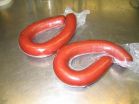Antimicrobial edible films inhibit pathogens in meat
2014-05-01
(Press-News.org) Antimicrobial agents incorporated into edible films applied to foods to seal in flavor, freshness and color can improve the microbiological safety of meats, according to researchers in Penn State's College of Agricultural Sciences.
Using films made of pullulan -- an edible, mostly tasteless, transparent polymer produced by the fungus Aureobasidium pulluns -- researchers evaluated the effectiveness of films containing essential oils derived from rosemary, oregano and nanoparticles against foodborne pathogens associated with meat and poultry.
The results demonstrate that the bacterial pathogens were inhibited significantly by the use of the antimicrobial films, said Catherine Cutter, professor of food science. She hopes that the research will lead to the application of edible, antimicrobial films to meat and poultry, either before packaging or, more likely, as part of the packaging process.
In the study, which was published online in the April issue of the Journal of Food Science, researchers determined survivability of bacterial pathogens after treatment with 2 percent oregano essential oil, 2 percent rosemary essential oil, zinc oxide nanoparticles or silver nanoparticles.
The compounds then were incorporated into edible films made from pullulan, and the researchers determined the antimicrobial activity of these films against bacterial pathogens inoculated onto petri dishes.
Finally, the researchers experimentally inoculated fresh and ready-to-eat meat and poultry products with bacterial pathogens, treated them with the pullulan films containing the essential oils and nanoparticles, vacuum packaged, and then evaluated for bacterial growth following refrigerated storage for up to three weeks.
"The results from this study demonstrated that edible films made from pullulan and incorporated with essential oils or nanoparticles have the potential to improve the safety of refrigerated, fresh or further-processed meat and poultry products," said Cutter. "The research shows that we can apply these food-grade films and have them do double duty -- releasing antimicrobials and imparting characteristics to protect and improve food we eat."
Working in Cutter's laboratory in the Department of Food Science, Mohamed Morsy, a doctoral student at Benha University in Egypt, conducted the research. Morsy was at Penn State as a Borlaug Fellow through a grant provided by the USDA-Foreign Agricultural Service.
The edible films are a novel but effective way to deliver antimicrobial agents to meats, Cutter explained, because the bacteria-killing action is longer lasting. Liquid applications run off the surface, are not absorbed and are less effective. The pullulan films adhere to the meat, allowing the incorporated antimicrobials to slowly dissolve, providing immediate and sustained kill of bacteria. In addition, the microorganisms do not have the opportunity to regrow.
Cutter conceded that pullulan films are not as oxygen-impermeable as plastic packaging now used to package meats, so the edible films are not likely to replace that material.
"The meat industry likes the properties of the polyethylene vacuum packaging materials that they are using now," she said. "However, the one thing I really want to be able to do in the next few years is to figure out a way to co-extrude antimicrobial, edible films with the polyethylene so we have the true oxygen barrier properties of the plastic with the antimicrobial properties of the edible film."
Knowing that edible films can release antimicrobials slowly over time and keep bacteria in meat at bay, further research will be aimed at creating what Cutter referred to as "active packaging" -- polyethylene film with antimicrobial properties.
"Right now, we have two different packaging materials that are not necessarily compatible, leading to a two-step process. I keep thinking there's a way to extrude edible, antimicrobial film in one layer with polyethylene, creating all-in-one packaging.
"The chemistry of binding the two together is the challenge, but we need to find a way to do it because marrying the two materials together in packaging would make foods -- especially meat and poultry -- safer to eat."
INFORMATION:
The U.S. Department of Agriculture-Foreign Agriculture Service, Borlaug Fellows Program and the Center for Food Manufacturing, Department of Food Science, Penn State supported this research.
ELSE PRESS RELEASES FROM THIS DATE:
Researchers find the accelerator for molecular machines
2014-05-01
How hard can it be to make a wheel rotate in a machine? Very hard actually, when the wheel sits in one of those nano-small molecular machines that are predicted to be running our future machines. But before the molecular machines become part of our daily lives, researchers must be able to control them. A Danish/American research team have now solved part of this problem.
There are large machines and there are small machines - and then there are molecular machines. They are nano-tiny collections of molecular building blocks that together make up a machine and operate various ...
Unlocking a mystery of thalidomide
2014-05-01
In the 1950s and 1960s, pregnant women with morning sickness were often prescribed the new drug thalidomide. Shortly after the medicine was released on the market, a reported 10,000 infants were born with an extreme form of the rare congenital phocomelia syndrome, which caused death in 50 percent of cases and severe physical and mental disabilities in others. Although various factors are now known to cause phocomelia, the prominent roots of the disease can be found in the use of the drug thalidomide.
Now, half a century later, new research by Dr. Noam Shomron, Prof ...
New study suggests combination of statin and omega-3 fatty acid may provide cardioprotective effects
2014-05-01
Boston, MA-- New findings from an in vitro study, led by researchers at Brigham and Women's Hospital (BWH), show that the combination of statins and eicosapentaenoic acid (EPA), an omega-3 fatty acid, may potentially reduce cardiovascular risk. This research is being presented May 1 at a peer-reviewed poster session at the National Lipid Association Scientific Sessions in Orlando, Florida.
"We know that endothelial cell dysfunction is emerging as an early and important predictor of cardiovascular disease and plays an essential role in plaque development. Treatments that ...
Risk of weight gain deters some smokers from seeking treatment to quit
2014-05-01
Smokers may avoid treatment to quit smoking if they previously gained weight while trying to quit, according to researchers at Penn State College of Medicine.
Weight gain is a predictable occurrence for smokers who have recently quit. Within the first year after quitting, they gain an average of eight to14 pounds, and some smokers report that they keep smoking simply because they do not want to gain weight from quitting.
Susan Veldheer, project manager in the Department of Public Health Sciences, predicted that smokers would avoid treatment to quit if they are highly ...
Experimental drug prolongs life span in mice
2014-05-01
CHICAGO --- Northwestern Medicine® scientists have newly identified a protein's key role in cell and physiological aging and have developed – in collaboration with Tohoku University in Japan -- an experimental drug that inhibits the protein's effect and prolonged the lifespan in a mouse model of accelerated aging.
The rapidly aging mice fed the experimental drug lived more than four times longer than a control group, and their lungs and vascular system were protected from accelerated aging, the new study reports.
The experimental drug could potentially be used to treat ...
Researchers reveal new cause of epilepsy
2014-05-01
A team of researchers from SUNY Downstate Medical Center (SUNY Downstate) and Sanford-Burnham Medical Research Institute (Sanford-Burnham) has found that deficiencies in hyaluronan, also known as hyaluronic acid or HA, can lead to spontaneous epileptic seizures. HA is a polysaccharide molecule widely distributed throughout connective, epithelial, and neural tissues, including the brain's extracellular space (ECS). Their findings, published on April 30 in The Journal of Neuroscience, equip scientists with key information that may lead to new therapeutic approaches to epilepsy. ...
Algae 'see' a wide range of light
2014-05-01
VIDEO:
Land plants detect light with pigments called phytochromes, which are sensitive to red light. But red light is absorbed by water, so aquatic algae have evolved phytochromes with a much...
Click here for more information.
Aquatic algae can sense an unexpectedly wide range of color, allowing them to sense and adapt to changing light conditions in lakes and oceans. The study by researchers at UC Davis was published earlier this year in the journal Proceedings of the National ...
Climate change to intensify important African weather systems, Stanford scientists say
2014-05-01
Weather systems that bring rainstorms to many drought-prone areas of northern Africa, carry Saharan dust across the ocean and seed Atlantic hurricanes could grow stronger as a result of human-caused climate change, a new analysis by Stanford scientists suggests.
Known as African easterly waves, or AEWs, these weather systems form above northern Africa during the summer season and travel east to west, toward the Atlantic Ocean.
"Not only are AEWs important for rainfall in West Africa, they also play a role in climate across the Atlantic, including here in the United ...
When it comes to classes, small is better
2014-05-01
Small classes, especially in the first four years of school, can have an important and lasting impact on student achievement, a new report shows.
In a review of over 100 papers from 1979-2014, education expert Dr David Zyngier from Monash University's Faculty of Education looked at whether the conclusions reached on the effect of smaller class sizes still hold true today.
"The question of class size continues to attract the attention of educational policymakers and researchers alike," Dr Zyngier said.
"Many argue that much of Australia's increased expenditure on education ...
Human rights report card released
2014-05-01
Real freedom, gender-based violence, terrorism laws, and asylum seekers' rights are all considered in a report released today on vital human rights issues in Australia and around the world.
The 2014 Castan Human Rights Report, by Monash University's Castan Centre for Human Rights Law, highlights the Centre's research and its relevance to some of the most important human rights issues facing society.
A key finding of the report is that freedom in Australia is being undermined.
Director of the Castan Centre Professor Sarah Joseph said the recent narrow debate on the ...

